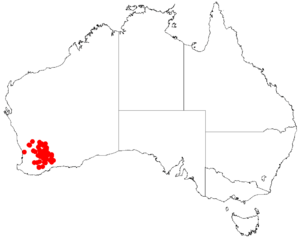Acacia acutata facts for kids
Quick facts for kids Acacia acutata |
|
|---|---|
| Scientific classification | |
| Genus: |
Acacia
|
| Species: |
acutata
|
 |
|
| Occurrence data from AVH | |
Acacia acutata is a type of shrub that belongs to the Acacia plant family. It is found only in the southwestern part of Australia, meaning it is endemic to that area.
What Does Acacia Acutata Look Like?
This interesting shrub usually grows to be about 0.3 to 1.2 metres (1 to 4 ft) tall. It has stiff branches that can be a bit spiky and are smooth, without any hairs. These branches also have fine lines or ridges. The plant has small, leaf-like parts called stipules, but they fall off early.
The leaves of Acacia acutata are actually not true leaves. They are modified leaf stalks called phyllodes. These phyllodes are stiff, green, and spread outwards. They are shaped like a triangle or a diamond and are attached directly to the stem without a stalk. Each phyllode is about 4 to 12 mm (0.16 to 0.47 in) long and 0.8 to 2 mm (0.031 to 0.079 in) wide. They have five veins, with one main vein that stands out.
This shrub blooms between September and October, producing bright yellow flowers. The flowers grow in small, round clusters, with each cluster having 11 to 15 golden flowers. After the flowers, the plant forms wavy, brown seed pods. These pods are rounded over the seeds inside and can grow up to 22 mm (0.87 in) long and 2.5 to 3 mm (0.098 to 0.118 in) wide. The seeds inside are mottled (have spots) and are about 2.5 mm (0.098 in) long, with an irregular oval shape.
Where Does Acacia Acutata Grow?
Acacia acutata naturally grows in the Great Southern and Wheatbelt regions of Western Australia. You can often find it growing near large rock formations called granite outcrops, or in flat, sandy areas known as sandplains. It prefers to grow in soils that are sandy, loamy (a mix of sand, silt, and clay), or clay-like, often with gravel.
Most of these shrubs are found in an area stretching from Wongan Hills in the north, down to Ongerup, and across to Lake King in the east. It is a common plant in different types of natural environments, including woodlands, mallee (a type of eucalyptus forest), shrublands, and heathlands.

